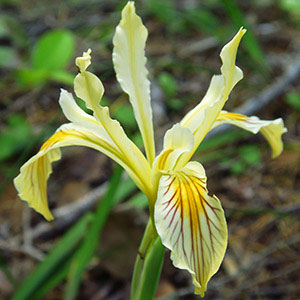Iris virginica
Iris bracteata
iris de virginie, southern blue flag, Virginia iris
Siskiyou iris
many-branched, forming dense clumps, 2–4 cm diam., usually covered with remnants of old leaves;
roots fleshy.
sheathed with old leaf bases, slender, 0.6–0.9 cm diam.;
roots few, fibrous.
rather weak, often falling over after flowering, solid, usually 1-branched, 5–10 dm.
simple, solid, 1.5–3 dm.
basal erect or often flexible, blade gray-green to bright green, buff to purplish basally, with several prominent ribs in mature leaves, linear-ensiform, 6–8 dm × 2.5–3 cm, apex acute.
basal with abaxial surface of blades deep glossy green on one side of fan, light yellow-green on other side, pink or red-tinged basally, strongly ribbed, 4–6 dm × 0.8–1 cm, rigid, margins not thickened;
cauline 3–6, imbricated, closely sheathing stem ca. 2/3 length, spreading distally, bractlike, blade inflated, often shorter than basal leaves.
2–3-flowered, branch units 1–2-flowered;
spathes compact, often with brown striations, ridged, unequal, outer 3–8 cm, inner 8–14 cm, firm, herbaceous.
simple, units 1–2-flowered;
spathes closed tightly around pedicel and ovary, lanceolate, 5.2–9 cm × 6–8 mm, subequal, herbaceous, margins scarious, apex acuminate.
perianth lavender to violet, rarely white;
floral tube constricted above ovary, 1–2 cm;
sepals spreading and arched, pale blue to purple with darker blue or purple lines, obovate to oval, 4–8.4 × 1.6–4 cm, base abruptly attenuate, claw green in median, bordered by yellow ground with blue or purple lines, yellow extending onto base of limb as finely pubescent signal patch;
petals oblong-lanceolate to oblong-spatulate, 3–7 × 1–3 cm, claw greenish yellow with blue or purplish lines, apex often emarginate;
ovary trigonal, 1.3–3.8 cm;
style inwardly auriculate at convergences, 3–4.5 cm, crests reflexed, 0.7–2 cm;
stigmas unlobed, with prominent triangular tongues, margins entire;
pedicel 2.5–8 cm.
perianth cream to buff-yellow;
floral tube 0.8–0.9 cm;
sepals with deeper yellow signal, veined with purple or brown, obovate-lanceolate, 6.5 × 2.5 cm, base gradually attenuate into wide claw;
petals narrowly oblanceolate, 7–9 × 0.8–2 cm, base gradually attenuate;
ovary nearly circular in cross section, 1.5–2.5 cm, base gradually attenuate into pedicel, apex abruptly acuminate into floral tube;
style 2.2–3 cm, crests spreading, yellow, not veined, 1.2 × 0.9–1.7 cm, margins toothed;
stigmas triangular or tongue-shaped, margins entire;
pedicel 3–6.2 cm.
ovoid, ellipsoid, or long-cylindric, trigonal or polygonal in cross section, 3–6 × 1–2 cm.
nearly circular in cross section, tapering abruptly at each end, 2–2.5 × 1–1.5 cm.
in 2 rows per locule, pale brown, usually D-shaped, 5–8 mm, pitted, corky.
dark brown, irregular in shape, wrinkled.
= 70, 72.
= 40.
Iris virginica
Iris bracteata
Plants of Iris virginica from the southeastern and south-central states having stems 2–3-branched and seldom falling to the ground after flowering, and with capsules long-cylindric have been recognized as var. shrevei.
(Discussion copyrighted by Flora of North America; reprinted with permission.)
Iris bracteata is limited to one county each in northern California and southern Oregon. It hybridizes with I. chrysophylla, I. douglasiana, I. innominata, I. munzii, I. purdyi, and I. tenax.
(Discussion copyrighted by Flora of North America; reprinted with permission.)


